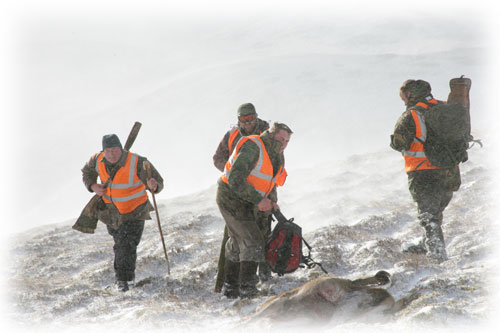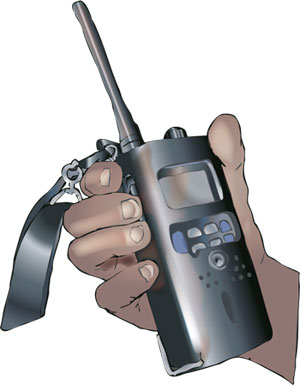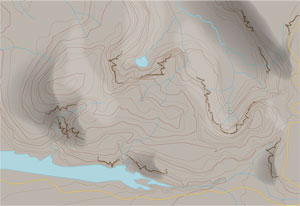Aim

The effectiveness of a cull operation may be increased by several rifles and support staff working as a team. The purpose of this guide is to describe factors to be considered when planning and implementing a team culling operation, whilst ensuring that safety and deer welfare standards are maintained. For this guide a team is taken to be more than two stalkers operating in either forest or open range environments.
Advantages
- Improves efficiency.
- Particularly useful to assist with large culls.
Constraints
- Requires ability to recover and larder large numbers of carcasses.
- Deer behaviour and movement may change in response to repeated collaborative culling operations.
- Carcasses may be spread over a wider area.
Most Efficient Where
- Weather and terrain combine to slow deer movement and increase the ability to predict how the deer will move.
- Rifles can move into position before the deer are aware of their presence.
- Rifles are positioned in areas which deer will move into.
Planning
Pre-operation planning should take into account the fact that the culling, extraction and processing of large numbers of carcasses is likely to be time consuming and labour intensive.

- Carry out a risk assessment *.
- Ensure compliance with relevant HSE Guidance** e.g. working time & manual handling regulations1.
- Ensure that specialist training has been provided in advance.
- Ensure that all communications equipment has been checked and is fit for purpose.
- Ensure that all team members have been equipped with the necessary protective clothing and equipment.
- Determine/Identify:
• The number of deer using the area where the cull is required, seasonal or weather variations, and how deer are likely to behave when disturbed or moved from the area.
• Suitable culling areas.
• The most effective method of extraction, taking into consideration number of carcasses expected, distance and terrain .
• Procedures to deal with the number of carcasses expected***.
• Whether helicopter support would be effective****. - Consult with neighbours prior to carrying out a substantial cull.
Communications
Communication is an essential component of any deer management activity involving a team and is particularly important in a culling operation.
- Ensure all team members are equipped with radios operating on a dedicated channel. Hands free radios make communication more efficient.
- Agree protocols for radio procedures before the start of any operation. Send, receive and acknowledge are essential steps. In addition team members should be clear on:
• Definition of terms to be used;
• Commencing and ending the operation;
• Moving position;
• Methods of relaying;
• Emergency procedures;
• Channel allocation.
Team requirements

- Establish clear command and control structures, identify who will be responsible for the overall operation, who will co-ordinate operations, and who the rifle-team leaders are.
- Ensure all team members are briefed on their role and the operational plan.
- Ensure all team-members understand and are able to follow procedures***** for:
• Radio communications (see Communications above).
• Moving during the operation.
• Dealing with wounded deer.
• Carcass traceability.
• Monitoring welfare.
• Carcass extraction.
• Contingencies including dealing with emergencies and severe weather.
• Arrival in area of third parties not involved in the operation. - Ensure that the individual with overall responsibility for the operation is satisfied that all those participating are capable of fulfilling their role.
- Ensure that there is communication between all team members.
- As an aid to safety, high visibility jackets should be worn by stalkers to help identify stalkers positions, particularly when the team-size exceeds 4 people. The size of teams will be dictated by the nature of the ground but the effectiveness of the team is likely to decrease if the team-size exceeds 12 rifles.
- It is helpful if team members have knowledge of the ground and local deer movements.
Moving deer to culling area.
Under authorisation from SNH, deer may be legally moved using a vehicle, to areas where they may be culled more efficiently or safely‡.
- If using a vehicle to move deer, ensure that SNHG Driving Deer With Vehicles: Code of Practice is followed.
Culling Operation
- Rifles move into position and only commence firing on instruction from the team leader.
- Stalkers targeting a specific group of deer must be aware of the location of all the members of the team targeting that group and be aware of arcs of fire.
- Any wounded animals are dealt with as a priority.
- All culling must stop at the instruction of the stalker in charge; all must acknowledge this instruction.
- Rifles to alert others when they cease firing.
Further useful information also available from HSE (also see BPG Useful Contacts)
also see: BPG Humane Dispatch, BPG Carcass Inspection, BPG Welfare Definition & Assessment, BPGs Carcass Extraction.
